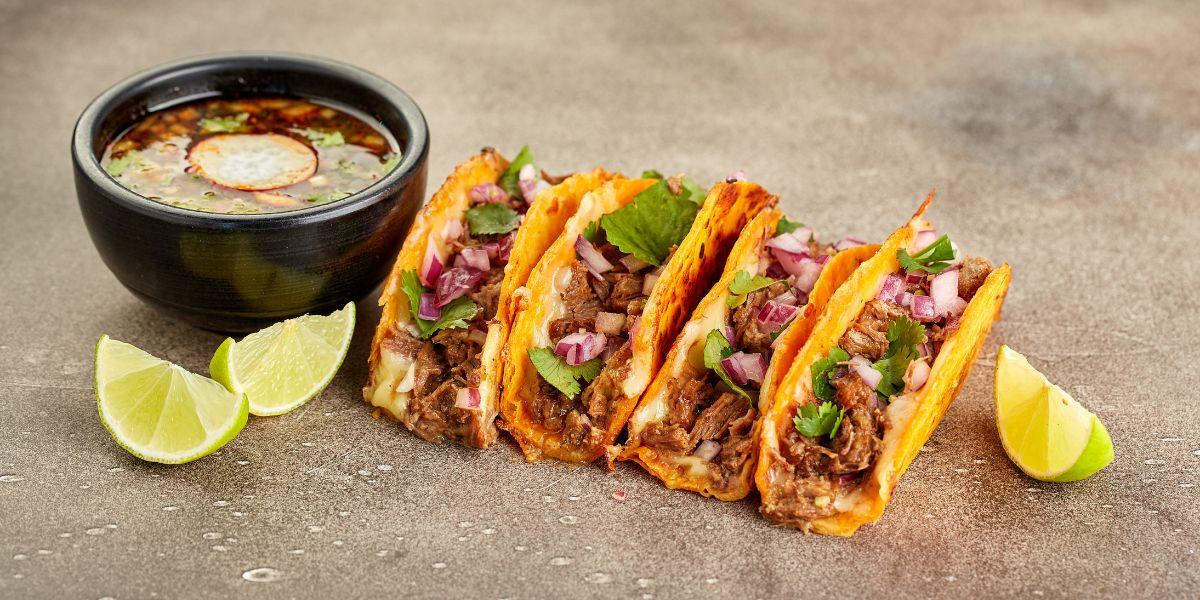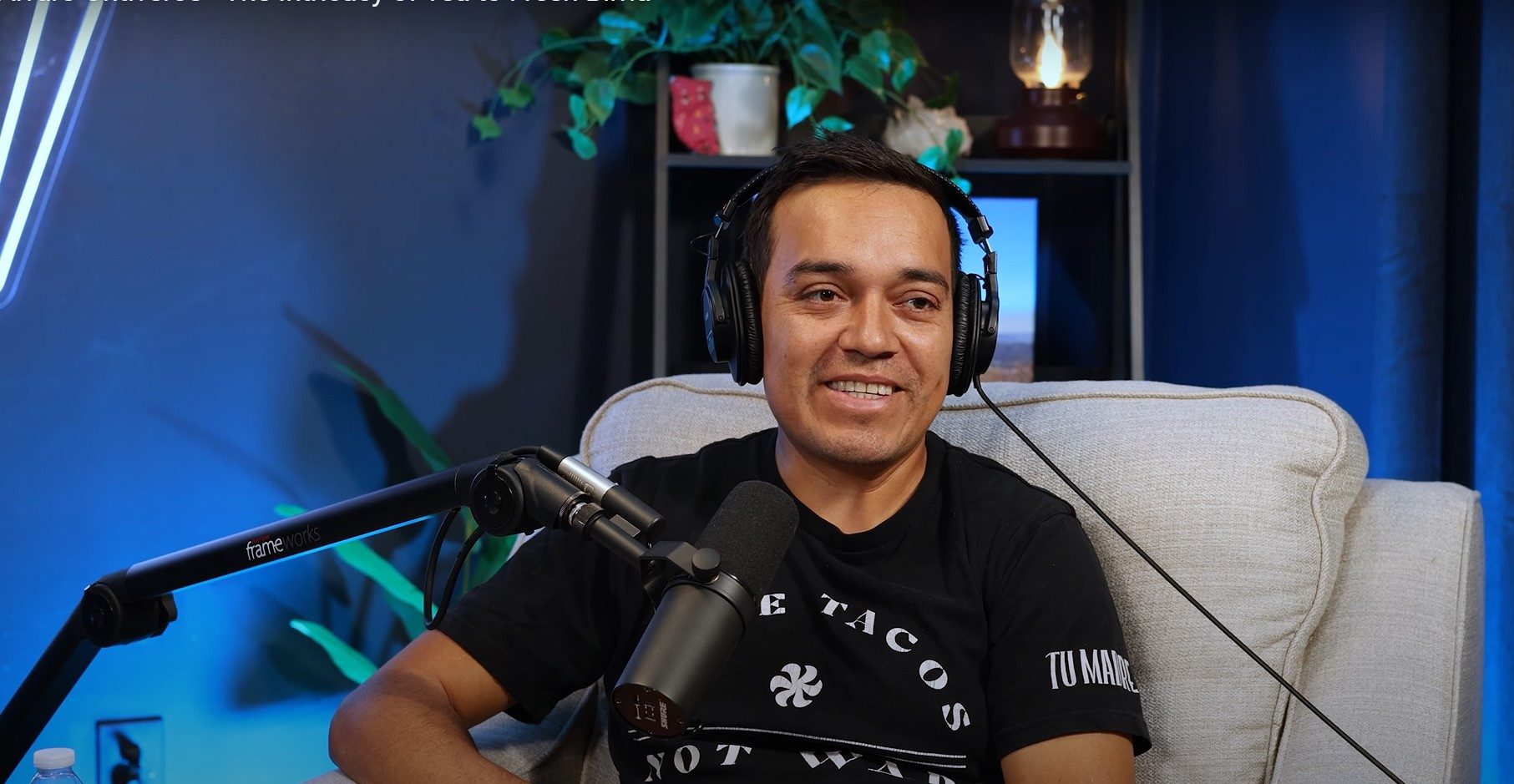Alvaro Ontiveros
The Intricacy of Tea to Fresh Birria
Episode 148
Alvaro Ontiveros is an immigrant from Mexico who first came over to spend time with his friends. During the pandemic in 2020 Alvaro started Birria Master when he lost his job in the tea industry. He started in Ave 26 with his own version of birria tacos and then soon made his way back to Pasadena as a taco truck.
Before his taco business took off, Alvaro had spent his working time in the restaurant industry, eventually ending up specifically inside the corporate tea industry for over a decade. During his journey before Birria Master Alvaro experienced every facet of working in a restaurant, from being a dishwasher, busing, serving, cooking and then managing, Alvaro leaned all the skills needed to run his own business (having a business degree also helped).
Today, Alvaro’s venture, Birria Master, has blossomed into one of the SGV’s premier spots for birria.
Location: 180 S Rosemead Blvd, Pasadena, CA 91107
Alvaro Ontiveros Takeaways
Alvaro Ontiveros, owner of Birria Master, originally came to the U.S. from Mexico at age 18, intending to stay for just a year, but ended up living in the San Gabriel Valley for 21 years. After he lost his job during the pandemic, Alvaro bought a griddle, tables, and a light with his last $1,500 to start selling tacos in December 2020 at a street food market. Initially he did this to get by during the pandemic with no real business plan. Despite humble beginnings with slow sales, shouting to attract customers, and borrowing equipment, Birria Master slowly grew its customer base.
After stints at various locations like Avenue 26 and Pico Rivera Sports Arena, he opened their current location, which now has a food trailer. His motivation to keep going during hard times was to provide for his family with a new baby. In addition to the birria tacos, he also created his own version of the Korean hot dog. The next goal is to open a full restaurant for Birria Master in the San Gabriel Valley area with its own dedicated space and parking lot.
Alvaro Ontiveros Quotes
“The First day was disappointing. It made me question my decision because we only sold a $120 investment. I started questioning my decision. I was like, oh, God, I think I made a mistake. That was one week of selling every day, the same amount: $150. And we took some time off for Christmas. I came back by myself and just kept working. Eventually, the sales started going up. We started getting popular. I got to a point months later that I quit my jobs.”
“I made Birria for the first time on December 16, 2020. I used the last money I had, about $1,500 left in my account, to buy a griddle, tables, a tent, and a basic light.
I had no tablecloth on my table. The containers for the salsa and cheese were from where I bought them at the Dollar Tree Store because I had no more money left. I had no generator for the lights, so I had to ask someone to let me borrow it from them when I set up next to them.”
“Before that happened, we started opening up in Highland Park. We relocated there for a very short period of time. Sales there were not great because we were in the middle of the pandemic. So there was not a lot of foot traffic, and there were not a lot of people on the streets.
I decided to close temporarily until we found a better location. So, Birria Master was closed for about two months.”
“When I got here, I focused on finding a job and a place to live. I didn’t speak the language, so I had to go to school for that. It was just a whole process. Everything’s happened in Pasadena.”
“My main motivation was my family. We had a one-year-old baby, and we found out we were pregnant again, so I had to keep going. When you’re a parent, there’s no choice. You just have to keep going.”
Show Notes
What is your connection to the San Gabriel Valley?
Well, I have lived in San Gabriel Valley for 21 years now. I was born and raised in Mexico and came to the US when I was 18 years old. I was a single guy, 18 years old, coming to the here on his own.
Where were you born in Mexico?
I was born in a small town called San Rafael in the municipality of El Marquez in the state of Queretaro. Queretaro is a small state about 3 hours north of Mexico City.
What led you to come to the US? What was the process like?
It’s a funny story. I came here just out of curiosity. I had friends who were here, so they would send me pictures and talk to me about it. So I was like, I’m going to live there for a year and then go back to my hometown. And that year turned into 21 years.
It was your choice to come here? It wasn’t something your family was making you do?
When I got here, I focused on finding a job and a place to live. I didn’t speak the language, so I had to go to school for that. It was just a whole process. Everything’s happened in Pasadena.
What did you do when you first came here?
My first job was as a dishwasher at Buca Di Beppo.
Was it exciting or scary when you first got here?
It was scary, but it was exciting at the same time. I remember the first time I walked on Villa Park, the difference in the city. You wouldn’t see a park like that in a normal neighborhood in Mexico; even though Villa Park is not one of the prettiest parks, it’s still way prettier than most of the parks in Mexico. I remember looking at the houses and the stores; everything looked different. So, everything for me was new and exciting at the beginning.
Were your friends here in Pasadena?
There was one friend in Pasadena, a few in Vegas, and then I had another friend, but he was in New York.
When you came here, what were you hoping your future would look like?
Initially, it was more about saving money to travel inside the country and get to know more about the country. As time passed, I started attending school to learn the language. So that turned into more of a drive to learn. I started taking business classes at Pasadena City College and working in an office.
But my drive at the beginning turned from just getting to travel in the country to learning about restaurant management. I think I always had this idea of opening my own restaurant, and it just seemed like a dream—almost an impossible dream to open your own restaurant in San Gabriel Valley because it’s so hard and expensive.
Where does your journey go after working in the office?
I worked for a tea company called International Tea Importers. I started in their tea shop in Pasadena, which was my first managerial job. I transferred to the corporate office, where I was the director of sales. I was with that company for over twelve years.
From working at the tea shop serving tables to managing for almost seven years and then transferring to the corporate office, it was a learning process. It was not easy, especially because my knowledge in tea was nonexistent. From there, I was transferred to sales, and then I had no idea how to do sales.
They deal with huge companies like Coca-Cola and Republic of Tea. Those are huge accounts. I had to talk to some of them, and it was just like talking to all these corporate people when you have no experience at all. I learned a lot from them in terms of structure and how to deal with big companies like this.
So when the pandemic pushed me to start my own business, all this knowledge I got from them was very helpful. I was doing marketing, sales, and events, and I traveled all over the country doing festivals and conventions, like the Bar and Restaurant Expo in Las Vegas. I do that every year now.
Are you still doing this?
I’m only doing the Bar and Restaurant Expo now. Now I’m working for the tea festival itself. When I left the company, they called me to work with them on tea cocktails. Since I have a background in bartending and tea, they wanted me to combine both tea cocktails.
Although tea and alcohol infusion has been around for a few years, it’s still new to most of the industry. Many bars don’t want to experiment with it because they lack an idea or working knowledge of tea.
Are you making new kinds of drinks?
Yeah, I had to create a new menu for them each year, but in the bars that I worked at, I was also making at least one tea cocktail was on the menu all the time.

You created Birria Master. Can you tell us more about it?
Birria Master started about three years ago. It’s funny that you mentioned Lord Empanada at the beginning because Ryan Lopez (Lord Empanada’s owner) is my friend.
We’ve known each other for a while, and I was there when he started his business. I’m very happy for him.
We started around the same time. During the pandemic, I lost my job. I was bartending, so I struggled to find a job.
Eventually, I went to one of the night markets in downtown LA. I don’t know if you remember Avenue 26, where the famous tacos were in Lincoln Heights. So, one of my friends invited me to go, and I saw all these vendors and thought I should do something. So I decided to open a taco spot, but I didn’t know what to do. And then I remember that one day, I had Birria tacos that I really liked. So, I wanted to make Birria tacos. But I didn’t know how to make them, so I had to go online on YouTube and watch like 50 different videos on how to make them. It was a success.
I blended all the different recipes I saw, and it was a process. It was not like the Birria was the best the first time we made it, but it was good. After about a year of making it five days a week, we got the process right. And that’s how Birria Master started.
So, you lost your job because of the pandemic and decided to start selling Birria tacos. When did you start selling to the public?
I made Birria for the first time on December 16, 2020. I used the last money I had, about $1,500 left in my account, to buy a griddle, tables, a tent, and a basic light.
I had no tablecloth on my table. The containers for the salsa and cheese were from where I bought them at the Dollar Tree Store because I had no more money left. I had no generator for the lights, so I had to ask someone to let me borrow it from them when I set up next to them.
The first day we started selling tacos, the Birria was really good, but no one knew us. They were going to the other stands next to us to get food, and then my friend would say, hey, tacos, tacos. Come over. They’re really good. So we were shouting in the middle of the street.
Was that at Avenue 26?
Yes. The first day was disappointing. It made me question my decision because we only sold $120. The salary to pay my friend who was helping me was going to be $130 per day. So, investment and all that, I started questioning my decision. I was like, oh, God, I think I made a mistake. We went back the next day to sell again, and that was one week of selling every day, the same amount, $150.
We took some time off for Christmas, and then I came back by myself. After that, I didn’t ask my friend to help me and just kept on working. Eventually, the sales started going up, and we started getting popular. A few months later, I actually quit my jobs and focused on building Birria Master by myself.
What kind of planning did you do when you first started? Did you know what was needed to be successful?
I’ll be completely honest with you. In the beginning, there was no business plan. It was more of an alternative source of income. The idea was to survive during the pandemic, sell tacos, and then go back to my regular job. That was the idea.
Your idea was to make money selling tacos to get through the pandemic?
Yes. I wanted to make money selling tacos, get out of the pandemic, and then go back to my normal job. That was the idea. As time went by and sales started increasing, that idea changed. Since I have some background in marketing and business planning, after the tea company, I started making sales projections and figuring out how much money I needed to make each day, how many tacos I needed to sell, work a little more on my food cost, finding better sources for my ingredients.
In the beginning, I bought my ingredients from the regular grocery store. Then, I opened an account at Restaurant Depot, which saved me money on my food costs because they do wholesale. Since I had a business license, I could save on taxes, which allowed me to have a bigger profit margin.
How long did you stay at Avenue 26?
Until late 2021, when he was shut down by the city.
Were you out of work then?
Before that happened, we started opening up in Highland Park. We relocated there for a very short period of time. Sales there were not great because we were in the middle of the pandemic. So there was not a lot of foot traffic, and there were not a lot of people on the streets.
I decided to close temporarily until we found a better location. So, Birria Master was closed for about two months.
When we shut down in early 2022, we got invited to sell inside Pico Rivera Sports Arena every weekend. That was our next spot.
So it was weekends only? Was that successful?
It was very successful. Our sales there were pretty good. We had more employees. Now we have four employees working our sales there. More than quadruple, I think up to that point, Birria Master was just another source of income. When we started doing bigger sales, and that’s when the idea hit me that this was an actual business. Now we have employees. This is my main source of income.
I started investing more in Birria Master. I bought more equipment, hired influencers to promote us on their pages, and then opened our second location, which is the one you saw us at on Rosemead Boulevard.
Are you still there on Rosemead near Colorado?
That’s our only location. We finally got our first food trailer about a month ago. So, we’re not setting up the tent anymore.
What’s the next step for you?
We almost opened a restaurant in Haven City in West Covina about six months ago. We got invited to join them and get a spot there. We were close to opening that place but decided to wait because we were a little afraid of the economy. But the next step for us is opening up our own restaurant.
Were there any points where you wanted to give up?
Yeah, definitely. That happened during the first two months when our sales were low, and I barely made enough money to survive. I seriously questioned myself, and the idea of just shutting down and going back to find a regular job was there, like, every day.
How did you push through that?
My main motivation was my family. We had a one-year-old baby, and we found out we were pregnant again, so I had to keep going. When you’re a parent, there’s no choice. You just have to keep going.
During the pandemic, we also opened a barbershop in front of my house. At the same time, I was working in the taco business. So I would come back from Birria Master in downtown LA and work on the shop, fixing things, painting, and setting up.
I created the website. I worked on that after the taco business from midnight to two or three in the morning and then went to sleep. So we just have to keep on pushing and going. There is no option. Luckily, Birria Master started doing better.
Do you cut hair in your barbershop?
No. My wife went to school to learn how to cut hair. I am not very comfortable touching other people’s hair, so I always tell her, jokingly, that I’m the cook in the family.
Do you have other barbers there?
My wife works there, and we have three more employees.
Is there a location you have in mind for your restaurant?
I think our location with the food trailer will be there as long as we can keep it there. We want to go somewhere in the San Gabriel Valley where we have our own space and our own parking lot. We don’t want to be next to like in a mall setting with all the other businesses just because we need our own space.
Can you explain what a Birria taco is?
Birria is originally from Guadalajara, Jalisco, and there are different styles. It got very popular in Tijuana when they started doing tacos and adding cheese, which they call queso tacos. The molita is the one with one tortilla at the bottom. Cheese and then tortilla on.
So, it’s a folded tortilla now with cheese in the middle and then the Birria. The Tijuana-style Birria tacos got so popular that they eventually crossed to San Diego and LA. But they’re different from the ones in Jalisco. So the ones in Jalisco, there’s the Jalisco style and there’s the Tijuana style.
Is Birria traditionally goat?
Yes, it’s traditionally goat.
Do you use goat or beef?
We use beef mainly because it’s easier to source, cheaper, and a lot of people don’t like goat. They’re a little afraid of the aftertaste.
What other food do you have? I know you have a Korean hot dog.
Yes, I saw it at a mall and was so curious. I bought one, but it was very disappointing because it looked really good but lacked flavor. But I liked the way it looked.
What does it look like?
It’s like an American corn dog, but the batter is different and comes with different toppings. So it could come with potatoes on the outside, like small cubes of potatoes that you deep fry along with the corn dog. Then, you add ketchup and mustard, or you can make a special aioli and put it on top. You can add hot Cheetos. You can add all these different ingredients, and they’re just really cool. The main difference is that inside the corn dog is half cheese and half sausage. So you get a cheesy corn dog, which is pretty good. So I started experimenting with it.
It took me about ten days to get the recipe right, and people love them. They’re really popular.
Thank you so much for joining us and sharing your story. Tell people how they can find Birria Master.
You can find us on Instagram @birriamaster. We’re located at 180 South Rosemead Boulevard in Pasadena. We always tell people that we’re across the street from the Dollar Tree store, which is the easiest way for them to find us.

Alvaro Ontiveros
Old Town Pasadena: I have so many memories there.
Foothill Restaurant: I have a lot of friends there, and I met a lot of great people there.
The Arboretum: I like to take the family and walk so you can see nature.








